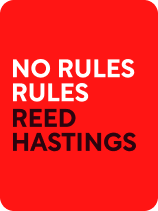

This article is an excerpt from the Shortform book guide to "No Rules Rules" by Reed Hastings. Shortform has the world's best summaries and analyses of books you should be reading.
Like this article? Sign up for a free trial here .
What is the No Rules Rules book about? What does Reed Hastings share about the unconventional and unique business practices at Netflix?
The No Rules Rules book is the guide to how Netflix operates. Author and Netflix CEO Reed Hastings discusses the often unconventional strategies that have been used to bring and maintain success for Netflix.
Keep reading for more about the No Rules Rules book by Reed Hastings.
No Rules Rules Book
When Netflix launched in 1997, the company was basically a mail-order version of Blockbuster, the video rental store that dominated the home entertainment industry at the time. Today, Netflix produces award-winning content, it has more than 167 million subscribers across 190 countries, and it’s consistently listed among the best places to work. To achieve this level of success, Netflix had to adapt and thrive in a rapidly changing industry. Identified in the No Rules Rules book, the keys to Netflix’s success have been unconventional business practices:
- Hire and keep only the best workers—at any cost.
- Promote candor through constant feedback at all levels as well as organizational transparency.
- Remove controls, such as allotted vacation time and approval processes.
These practices have created a company culture that focuses on empowering employees to innovate and take accountability, rather than conditioning them to simply follow protocol. Through this book, Netflix CEO Reed Hastings tells the story of Netflix’s evolution and his logic in cultivating this kind of culture, while co-author and business professor Erin Meyer provides context for how these unusual business practices shaped the company’s success.
Step 1: Hire and Keep Only the Best Employees
A few years after Netflix’s 1998 launch, the company was hit with the repercussions of the 2001 dot-com crash. Venture capital funds dried up and Hastings was forced to lay off a third of his 120 employees, including many who worked hard and produced adequate work. Although Hastings feared that the layoffs would decimate morale, he discovered that his remaining staff buzzed with energy and produced high-quality work. Hastings soon realized that by eliminating less-than-stellar workers, he’d raised the talent density, meaning that there was a higher level of talent per employee, and that created an environment in which top performers thrived. High-performing employees want to work at companies full of talented, collaborative workers because:
- They improve by learning from other top performers.
- They push each other to produce high-quality work, which increases individual motivation and satisfaction.
Performance—whether good or bad—is contagious, according to the No Rules Rules book. Hastings hadn’t realized that, before the layoffs, the mere presence of adequate employees had been dragging down the performance of his entire team. On a team of high performers, just one or two mediocre workers can have adverse effects:
- They reduce efficiency by forcing others to find ways of working around their less-than-stellar performance.
- They bring down the quality of group discussion.
- They take managers’ energy and attention away from top performers.
- They cause the team to produce lower-quality work, which causes some high-performing employees to quit out of frustration.
- Their presence sends a message to everyone else that company leaders condone mediocrity, which reduces motivation and performance across the board.
By contrast, a team full of highly talented people pushes everyone’s performance up.
Step 2: Promote Candid, Frequent Feedback
With an office full of talented, collaborative employees, Hastings learned that he could maximize their potential by promoting frequent, candid feedback. Once employees adapted to giving and receiving candid feedback, the exchanges raised everyone’s performance:
- The increased exchange of candid feedback helped people know how they could improve, which raised individual and company-wide performance.
- Frequent critiques increased the pace of work progress, as people learned more quickly and increased their effectiveness.
- Direct feedback promoted open communication and prevented misunderstandings.
- Candor created an atmosphere of co-accountability, in which everyone kept each other on point (instead of only managers having the authority to correct others).
Hastings encouraged employees to be candid with everyone on the team—superiors, colleagues, and subordinates. In fact, frequent feedback became so ingrained in Netflix’s office culture that not speaking up was considered an act of disloyalty, because it inhibited the company’s improvement. Feedback is a key part of the No Rules Rules book.
Step 3: Eliminate Controls Identified in the No Rules Rules Book
With a highly motivated staff and a culture of candor and accountability, Hastings was able to give his staff more freedom by removing controls, such as the vacation policy and the travel and expense approval processes. He discovered that when companies have policies and processes to control employees’ behavior, it makes people feel that their judgment is being undermined, which kills the creative atmosphere. By contrast, when employees have more freedom, they act more responsibly, and as they act more responsibly, management can feel confident offering more freedom. Additionally, removing controls:
- Supports innovation
- Speeds up workflow
- Promotes adaptability
First, Hastings eliminated the vacation policy, meaning that Netflix neither allotted vacation time nor tracked days off. In order to prevent employees from taking too much vacation, he instructed managers to provide plenty of context for employees to make good decisions—for example, don’t take a vacation at a time when it would hurt your team. On the other hand, to ensure that employees still took enough vacation, he encouraged leadership at all levels to take big vacations, talk openly about them, and encourage employees to do the same.
Next, Hastings eliminated travel and expense approvals. Netflix’s policy was to simply act in the company’s best interest. For instance, it’s in the company’s best interest for an employee to take economy class flights unless she has to take a redeye to present at a conference first thing in the morning, in which case flying business class would help her get some rest on the plane and be alert for her presentation. This policy empowers employees to use their judgment, but it also requires:
- Context: Without strict guidelines, managers need to give employees the context to understand what their bosses consider appropriate and inappropriate, so that they can make wise decisions. We’ll explain more about how to provide context later.
- Safeguards: Managers must regularly check at least a sampling of employees’ expenses, and employees must know that there’s always a chance that their bosses could be monitoring their actions.
- Transparency: To reinforce the threat of getting caught, managers must tell their employees when someone is fired for overspending.

———End of Preview———
Like what you just read? Read the rest of the world's best book summary and analysis of Reed Hastings's "No Rules Rules" at Shortform .
Here's what you'll find in our full No Rules Rules summary :
- How Netflix achieved massive success in a short period of time
- The unusual business practices that have helped Netflix sustain its success
- Why Netflix fires adequate employees






